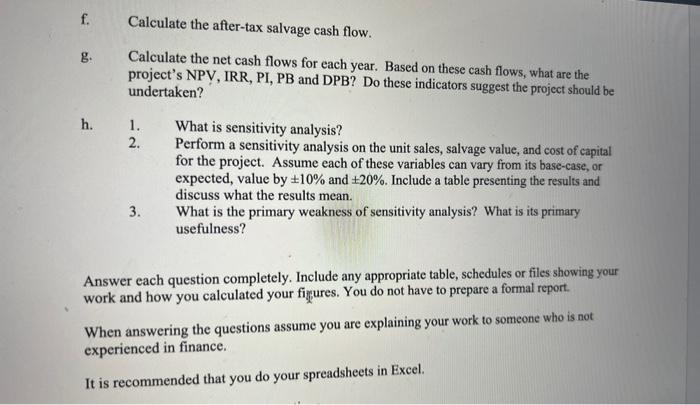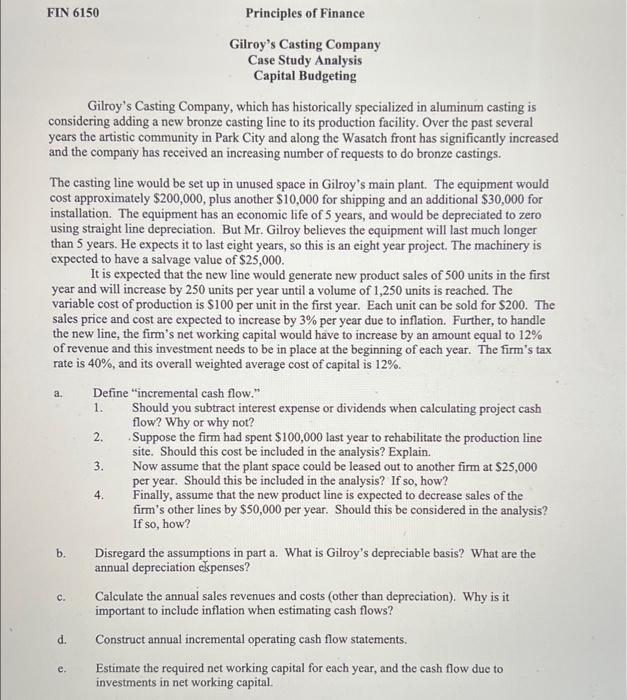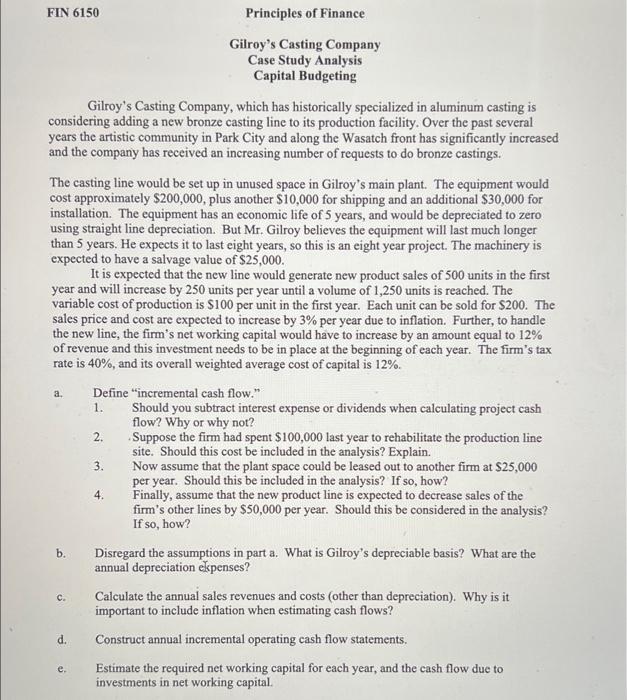f. Calculate the after-tax salvage cash flow. g. Calculate the net cash flows for each year. Based on these cash flows, what are the project's NPV, IRR, PI, PB and DPB? Do these indicators suggest the project should be undertaken? h. 1. What is sensitivity analysis? 2. Perform a sensitivity analysis on the unit sales, salvage value, and cost of capital for the project. Assume each of these variables can vary from its base-case, or expected, value by \pm10 and \pm20. Include a table presenting the results and discuss what the results mean. 3. What is the primary weakness of sensitivity analysis? What is its primary usefulness? Answer each question completely. Include any appropriate table, schedules or files showing your work and how you calculated your fizures. You do not have to prepare a formal report. When answering the questions assume you are explaining your work to someone who is not experienced in finance. It is recommended that you do your spreadsheets in Excel. FIN 6150 Principles of Finance Gilroy's Casting Company Case Study Analysis Capital Budgeting Gilroy's Casting Company, which has historically specialized in aluminum casting is considering adding a new bronze casting line to its production facility. Over the past several years the artistic community in Park City and along the Wasatch front has significantly increased and the company has received an increasing number of requests to do bronze castings. The casting line would be set up in unused space in Gilroy's main plant. The equipment would cost approximately \\( \\$ 200,000 \\), plus another \\( \\$ 10,000 \\) for shipping and an additional \\( \\$ 30,000 \\) for installation. The equipment has an economic life of 5 years, and would be depreciated to zero using straight line depreciation. But Mr. Gilroy believes the equipment will last much longer than 5 years. He expects it to last eight years, so this is an eight year project. The machinery is expected to have a salvage value of \\( \\$ 25,000 \\). It is expected that the new line would generate new product sales of 500 units in the first year and will increase by 250 units per year until a volume of 1,250 units is reached. The variable cost of production is \\( \\$ 100 \\) per unit in the first year. Each unit can be sold for \\( \\$ 200 \\). The sales price and cost are expected to increase by \3 per year due to inflation. Further, to handle the new line, the firm's net working capital would have to increase by an amount equal to \12 of revenue and this investment needs to be in place at the beginning of each year. The firm's tax rate is \40, and its overall weighted average cost of capital is \12. a. Define \"incremental cash flow.\" 1. Should you subtract interest expense or dividends when calculating project cash flow? Why or why not? 2. Suppose the firm had spent \\( \\$ 100,000 \\) last year to rehabilitate the production line site. Should this cost be included in the analysis? Explain. 3. Now assume that the plant space could be leased out to another firm at \\( \\$ 25,000 \\) per year. Should this be included in the analysis? If so, how? 4. Finally, assume that the new product line is expected to decrease sales of the firm's other lines by \\( \\$ 50,000 \\) per year. Should this be considered in the analysis? If so, how? b. Disregard the assumptions in part a. What is Gilroy's depreciable basis? What are the annual depreciation kpenses? c. Calculate the annual sales revenues and costs (other than depreciation). Why is it important to include inflation when estimating cash flows? d. Construct annual incremental operating cash flow statements. e. Estimate the required net working capital for each year, and the cash flow due to investments in net working capital. FIN 6150 Principles of Finance Gilroy's Casting Company Case Study Analysis Capital Budgeting Gilroy's Casting Company, which has historically specialized in aluminum casting is considering adding a new bronze casting line to its production facility. Over the past several years the artistic community in Park City and along the Wasatch front has significantly increased and the company has received an increasing number of requests to do bronze castings. The casting line would be set up in unused space in Gilroy's main plant. The equipment would cost approximately \\( \\$ 200,000 \\), plus another \\( \\$ 10,000 \\) for shipping and an additional \\( \\$ 30,000 \\) for installation. The equipment has an economic life of 5 years, and would be depreciated to zero using straight line depreciation. But Mr. Gilroy believes the equipment will last much longer than 5 years. He expects it to last eight years, so this is an eight year project. The machinery is expected to have a salvage value of \\( \\$ 25,000 \\). It is expected that the new line would generate new product sales of 500 units in the first year and will increase by 250 units per year until a volume of 1,250 units is reached. The variable cost of production is \\( \\$ 100 \\) per unit in the first year. Each unit can be sold for \\( \\$ 200 \\). The sales price and cost are expected to increase by \3 per year due to inflation. Further, to handle the new line, the firm's net working capital would have to increase by an amount equal to \12 of revenue and this investment needs to be in place at the beginning of each year. The firm's tax rate is \40, and its overall weighted average cost of capital is \12. a. Define \"incremental cash flow.\" 1. Should you subtract interest expense or dividends when calculating project cash flow? Why or why not? 2. Suppose the firm had spent \\( \\$ 100,000 \\) last year to rehabilitate the production line site. Should this cost be included in the analysis? Explain. 3. Now assume that the plant space could be leased out to another firm at \\( \\$ 25,000 \\) per year. Should this be included in the analysis? If so, how? 4. Finally, assume that the new product line is expected to decrease sales of the firm's other lines by \\( \\$ 50,000 \\) per year. Should this be considered in the analysis? If so, how? b. Disregard the assumptions in part a. What is Gilroy's depreciable basis? What are the annual depreciation kpenses? c. Calculate the annual sales revenues and costs (other than depreciation). Why is it important to include inflation when estimating cash flows? d. Construct annual incremental operating cash flow statements. e. Estimate the required net working capital for each year, and the cash flow due to investments in net working capital









